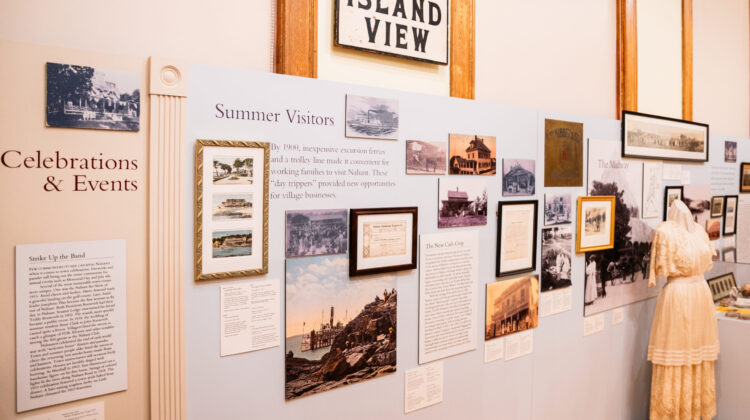“Nahant on the Rocks” takes its visitors back in time for an interactive history lesson. The Nahant Historical Society’s first permanent exhibition first opened in 2003, filling the Nahant Community Center’s Lowell Room Gallery to the brim with authentic objects, structures, photos, and clothing from various times periods throughout the town’s history. The exhibit’s name is inspired by late historian and former NHS President Stanley Patterson, who authored the most recent book documenting Nahant’s history — also titled “Nahant on the Rocks.”
A large and talented team, headed by former curator Calantha Sears, was responsible for doing the research, gathering the resources, and bringing the exhibition to life. According to NHS Executive Director Julie Tarmy, Sears is still as involved as ever today, despite being 101 years old.
“She’s the oldest person in Nahant,” Tarmy said. “She still lives alone and is sharp as a tack. She’s still our leader, she’s my boss.”
A life-size cardboard cutout of Sears stands in Tarmy’s office, along with some newly acquired historical relics that the society will attempt to display in different exhibits.
It is unlikely, however, that “Nahant on the Rocks” will see any significant additions, as the project was designed to tell a complete and contained story. So far, it has accomplished its mission of being “Nahant in a nutshell.”
The first thing tourists encounter upon entering the exhibit is the porch structure, designed to replicate the atmosphere of the summer homes some of Boston’s wealthiest owned in town. The walkthrough starts with a highlight of some of the town’s earliest entrepreneurial and scientific minds during the 19th century. Those include refrigeration pioneer Frederic Tudor, marine biologist Louis Agassiz, and Nahant Public Library founder William Wood.
“Over the years we’ve come to realize that Nahant seems to be a magnet for talent and philanthropic persons,” Tarmy said.
Wood and Tudor were driving forces behind the original forestation of Nahant.
Another noteworthy portion of the exhibit details Nahant’s surprising military history, which dates back to the Spanish-American War. Tarmy personally remembers how her unsuspecting hometown was once the home of heavy weaponry during the Cold War as well.
“We had three bays with missiles,” Tarmy explained. “I remember as a child they would test them by raising them up.”
Tarmy also explained that the military bays had guns that had regular test fires.
“We were a major part in the protection of Boston Harbor,” she said.
An authentic late-19th-century wooden tennis racket hangs on the wall of the next turn at the exhibit. It commemorates the first ever American game of lawn tennis, which was supposedly played on Nahant grass.
“There is another town that will spar with us on this, but it was here in Nahant,” Tarmy said.
The political corner of “Nahant on the Rocks” is centered around the former U.S. Sen. Henry Cabot Lodge. The Beverly native had a summer home of his own in town, and some of his relatives remain local to this day. Presidents Theodore and Franklin Roosevelt both visited Nahant numerous times, and the former was a friend of Lodge.
The fire-and-police portion of the exhibit is a favorite among youths, with its interactive bell siren and bullhorn. The midway demonstration breaks down some of the activities the town’s carnival had to offer, along with some ceramic prizes that could be won.
“These seem to last longer than today’s prizes,” Tarmy joked. “You could put melted butter in the lobster creamer.”
Egg Rock is one of the iconic landmarks of Nahant. At the exhibition, visitors can take a step further into its history by learning about people such as George Taylor, Egg Rock’s first lighthouse keeper. However, Taylor did not keep his position long, as he lost it for a controversial reason.
“When Lincoln came up for president, he didn’t vote for him,” Tarmy said. “So he lost his job because it was a government job.”
“Nahant on the Rocks” has seen many visitors since its inception, and Tarmy is confident that is not going to change anytime soon.
“It’s very popular, we have a lot of people come here,” Tarmy noted. “When people do come here, they want to learn a little something about Nahant, and when we open that door they go ‘Wow, I wasn’t expecting this!’ And then they tell their friends.”












